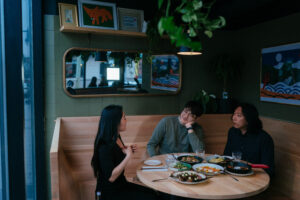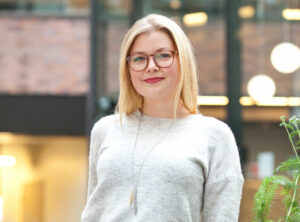
Environment
Farming a changing sea
Struggle and success in Atlantic Canada, where aquaculturists strive to overcome climate change and contamination while chasing a sustainable carbon footprint
- 4058 words
- 17 minutes
Travel
Susan Nerberg embarks on a deeply personal tour of Tromsø, taking part in Sámi Week as a means to better understand her own Sámi roots and culture

The Paris of the north, the Gateway to the Arctic, the Northern Lights Capital of the World: the city of Tromsø boasts many names reflecting the shape it takes in people’s (and marketers’) minds. And sure, on a clear winter night, you might be lucky to see the aurora borealis brighten the backdrop to the famous Arctic Cathedral, whose design resembles overlapping sheets of ice. But as I walk along the wooden storehouses that line the historic wharf of this Norwegian coastal hub, the lightshow above consists of snowflakes sliding down beams shed by streetlamps. The city at this moment is hushed.
It’s an entirely different scene than the one that must have unfolded back in the heyday of polar exploration, when Roald Amundsen and Fridtjof Nansen landed here on their Arctic adventures, and when whaling ships and hunting expeditions left for the Svalbard Archipelago and at least once came back with an orphaned (and probably terrified) polar bear cub that was paraded along the Storgata main street to residents’ delight.

As my steps fall silently on the snow, I think about the bravado that has contributed to Tromsø’s swagger as a frontier town and forward-looking community. It’s still adventure central, with dog sledding, ski touring and sailing on the menu. And the tourism ads don’t lie: Tromsø is a gorgeous city, on the sea, surrounded by mountains, enlightened by theatres and art galleries and one of Norway’s largest universities, and — yes, sometimes — gussied up by northern lights. I appreciate all that. The thing is, this often-repeated image ignores a quieter but no less important reality: that Tromsø and Kvaløya, the island where part of the city is located, have always been home to the Indigenous Sámi, a people who frown on braggadocio.
On previous visits, I’ve rarely heard of the city being referred to as a Sámi place, even though Sámi people have lived in this part of Norway since long before Norway became, well, Norway. In fact, the Sámi have lived here and elsewhere in Sápmi, the Sámi home-land, which stretches across northern Norway, Sweden and Finland and Russia’s Kola Peninsula, since time immemorial. I’ve come here to explore a culture that tends to tread silently, as if on snow, but still manages to dazzle like the aurora. I’m here to find Tromsø’s Sámi side.

NIKO VALKEAPÄÄ takes a deep breath. When he lets it out again, his voice seems to unleash a pack of wolves. It howls, runs, keeps going until the wolves have passed nine valleys by dawn. They don’t run fast, but they run far, and soon Valkeapää is out of breath. When he catches it again, he explains that what he just did was perform a joik — the wolf joik, to be specific. “In joik,” he says, “you don’t joik about an animal or about a person or place for that matter. You joik the animal, capturing its spirit, habits and characteristics.” The wolf isn’t the swiftest of animals, but it has stamina, which is why Valkeapää draws out the notes, long “lo,” “no,” “go” and “nu” sounds that also reflect the length and breadth of the valleys the wolf pack runs through. Contrast that with the ptarmigan: as Valkeapää creates and projects tones from the far back of his mouth, you can see the bird running in your mind’s eye, drumroll steps that stop abruptly and only long enough to ascertain its safe passage, in silence, before getting going again.

A singer and joiker who mixes joik and pop music and who released his eighth album this past September, Valkeapää is teaching a drop-in class in the Sámi singing form as part of the program at Sámi Week, an annual celebration and showcase of Sámi culture, knowledge and language that centres Sámi National Day (February 6). Most of the class attendees are tourists who’ve come to Tromsø to see the northern lights and get a chance to feed reindeer at one of several reindeer safari experiences in the area. Sámi Week, or Sámi Vahkku in the North Sámi language, is a welcome surprise, a bonus, for them. There’s a couple from France, a woman from the United States and another from Brazil, and people from the United Kingdom, Belgium, Germany and Sweden, plus an international cast of students enrolled at the University of Tromsø — all ready to dig into instruction in joik, language and handicrafts; movie screenings and album releases; pizza nights and reindeer racing (but not at the same time).
My motives for being at Sámi Vahkku are deeply personal. I’m in the (lifelong) process of uncovering, reclaiming and embracing my Sámi roots. I didn’t grow up hearing joik, learning the Sámi language or making and adorning leather, wood and bone objects for everyday use. And yet two of my grandparents were Sámi; they had North Sámi, one of 9 living Sámi languages (at least two others are extinct), as their mother tongue. Unfortunately, I’m proof that nearly 1,000 years of colonialism, enhanced by an official assimilation policy called Norwegianization that lasted from 1850 to around the 1960s and included residential schools, worked pretty much the way the Norwegian state intended. As a result, my grandparents were compelled to set their children up for an easier life, one free from racism, so they raised them as Norwegians. Thousands of families were robbed of their heritage, my dad and me included.


So coming to Tromsø for Sámi Vahkku feels a bit like an act of defiance, because it proves that we are still here — the ones who have never forgotten who they are, and the ones, like me, who are unforgetting. Take Jorunn Løkvold. She is educated as a duojár, an artisan who creates duodji, Sámi handicrafts. Løkvold specializes in sewing gákti, the Sámi regalia that uses a different ornamentation around the neck and shoulders and on sleeve ends and hem, depending on where the wearer comes from or has roots. She also makes Sámi capes and hoodies, as well as belts that incorporate riebangolli (fool’s gold or mica) for pizzazz. But at the festival, she’s teaching a room full of people how to sew a coffee bag, a traditional leather pouch for carrying coffee while out on the land. “It’s important to show what duodji is and how long it takes to make something by hand, because it’s our history,” she says.

Sunniva Marthinsen Brox agrees. Working with leather is new to her, but the craft aspect is not. “I was raised in a Norwegian home, but as an adult, I’ve taken back our Sámi heritage.” Brox says she’s a duojár-in-the-making, but her chosen medium is silver, which she crafts into jewelry. “Our foremothers and forefathers went through a lot of pain, and there are still many wounds that need to heal,” she says, tugging at a sinew thread. “But the time has come to feel free to be who we are. I can feel my great-grandmother’s pat on my back.”
Løkvold, Brox and other duojarat represent a different kind of mettle than the one Tromsø might prefer to promote: a quiet resistance, a move to take back and make visible, to make a mark, to get up and stand up. There’s no need to be loud to be brave.


I’M STANDING FACE to photographed face with the world’s largest portrait of a Sámi person. The man depicted is Per Savio, whose likeness, at 13 metres tall, dominates the atrium at the Fram Centre. As part of Sámi Week, the scientific research complex on the waterfront is hosting a seminar about Savio and Ole Must — likely the first Sámi men to travel to Antarctica. In May 1898, Savio and Must set sail aboard the Southern Cross, becoming part of the first expedition to overwinter on the Antarctic mainland, more than a decade before Robert Scott’s famed Terra Nova Expedition.
Ann Kristin Balto, herself Sámi and the centre’s photo archivist, found an album with pictures from the Southern Cross Expedition. “I’d never heard of any Sámi participating in Antarctica, so discovering the album was a big surprise,” she says, addressing a group of people who’ve come to learn about the Sámi presence in Antarctica.
For the Southern Cross Expedition, leader Carsten Borchgrevink wanted two Sámi men with ski experience who knew how to handle and care for dogs. What he got were two men with life-saving traditional knowledge: not only were Savio and Must adept at sewing clothing from reindeer skin and fur (the hairs are hollow, keeping the crew warm even in Antarctica), but they also brought loads of lesser bladder-sedge, a grass used to insulate footwear. (Carex vesicaria has been used across Sápmi for centuries to keep feet warm in winter; in North America, Indigenous Peoples use it to weave baskets.) Savio and Must also knew how to manage polar night (a.k.a. seasonal affective disorder), loneliness and extreme cold — all guaranteed on trips to the southern antipode — and were instrumental in catching and preparing fish, including a handful of new species, for later analysis and classification.

Even though Savio and Must didn’t make it into mainstream books written about the Borchgrevink journey, they figure in the crew members’ diaries as intelligent, brave and hard-working men. In my mind, they also figure as scientists in their own right — for what is Indigenous knowledge gathered from long-term observations of animals, climate and the environment but scientific?
When I head outside, the snow has turned to rain. The scene resembles a tap dance on the pavement. I make my way along Storgata, where a few days earlier I wore gákti and marched with a group of sisters and brothers to mark Sámi People’s Day. Pride hung in the air, making me feel taller than my 5-foot-3. This afternoon, I pick up the scent of the sea. I look south, toward the mountains that separate the Lyngen Fjord from Ullsfjorden. The area, where my grandfather, great-grandparents and their relations lived, is referred to, thanks to tourism marketing, as the Lyngen Alps, jagged peaks that cut a gash in the clouds. My ancestors were Coastal Sámi; they fished, kept sheep and maybe a cow or two, and cut hay for winter feed. In the summers, they might have met and traded with and found husbands and wives among the herding families who brought their reindeer from the Swedish and Finnish sides of the border to summer pastures on the coast — until the borders were closed, forcing many to choose on which side to settle, severing family ties.
The attempted erasure of my people has led not only to a disturbance of family ties, but also to a loss of Sámi names. In Tromsø, there isn’t a single street address in Sámi, something that, according to Aud-Kirsti Pedersen, shows a lack of recognition of the Sámi history of the place. At least Tromsø itself has a name in the North Sámi language — Romsa — as do several mountains, fjords and rivers in the region beyond.

A linguist, Pedersen works several floors up from the giant portrait of Savio, in the Fram Centre. As the Norwegian Map Authority’s head of place names for northern Norway, she handles the registration of Sámi place names (and names in Kven, the other official minority language in the north). She explains that when Sámi names are proposed for entry in address records and onto maps, special consideration is given to names used in the spoken language since Sámi culture is based on oral tradition. This is to strengthen the official use of place names in minority languages. But it isn’t necessarily easy, as there are often people who oppose including Sámi names. “Sometimes the arguments against are as banal as there not being enough space on a certain line in a database to accommodate more than one name,” she says. “Other times it comes down to officials saying emergency services might miss a call if they can’t understand the address they’re going to. And in 2011, when there was a proposal to make Tromsø a Sámi language management area, there was opposition from some people who argued Tromsø had always been Norwegian.”
I visited the city that year and remember reading the local news, including letters to the editor with harsh comments against the proposal. But Pedersen says that, in general, people’s attitudes have softened since then and more municipalities are actively working on adding Sámi names in the records. In 2011, there were 193 official Sámi place names; by February 2023, there were 969. And who knows, perhaps by the time Sámi Vahkku 2024 rolls around, the city will have its first Sámi street address. “Names we hear are important,” Pedersen says. “But we need to make the invisible become visible, because it underscores Sámi historical presence.”
On the last day of Sámi Week, the main street is taken over by reindeer. Loud joik blasts out of speakers as reindeer racers, skis in hand, walk their animals to the start gate behind a group of men wearing gákti. Any hint of Sámi quietness or invisibility is gone. The sidewalks are so packed some spectators have climbed up onto the streetlights to get a better view. When the racers reach the start line, they turn around, click into their ski bindings and settle in behind their reindeer. Three! Two! One! The race lasts for no more than 20 seconds, less for the best competitors, on the 201-metre-long track. The air is boiling with sound, and it’s impossible to miss the message: We are still here, and we’re not going anywhere. But everyone’s welcome to listen in — to hear with the heart and mind the joik lessons, the language classes, the duodji instruction and the reindeer race. Just don’t forget to pay attention to the silent steps on snow.
Are you passionate about Canadian geography?
You can support Canadian Geographic in 3 ways:

This story is from the November/December 2023 Issue

Environment
Struggle and success in Atlantic Canada, where aquaculturists strive to overcome climate change and contamination while chasing a sustainable carbon footprint

People & Culture
In honour of Asian Heritage Month, CBC Quebec journalists asked Asian Canadians how they carry their culture

Travel
Jill Doucette, founder and CEO of Synergy Enterprises, shares insights on new trends in the tourism industry and why there’s reason to be optimistic about a sustainable future for travel

Travel
George Kourounis recounts his unforgettable experience travelling through Egypt with Exodus Travels